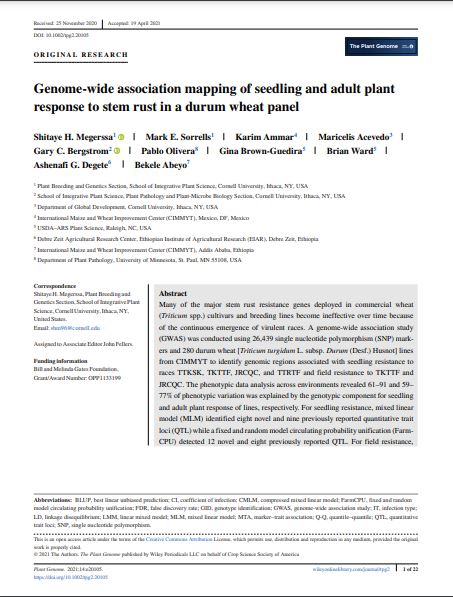Many of the major stem rust resistance genes deployed in commercial wheat (Triticum spp.) cultivars and breeding lines become ineffective over time because of the continuous emergence of virulent races. A genome-wide association study (GWAS) was conducted using 26,439 single nucleotide polymorphism (SNP) markers and 280 durum wheat [Triticum turgidum L. subsp. Durum (Desf.) Husnot] lines from CIMMYT to identify genomic regions associated with seedling resistance to races TTKSK, TKTTF, JRCQC, and TTRTF and field resistance to TKTTF and JRCQC. The phenotypic data analysis across environments revealed 61–91 and 59–77% of phenotypic variation was explained by the genotypic component for seedling and adult plant response of lines, respectively. For seedling resistance, mixed linear model (MLM) identified eight novel and nine previously reported quantitative trait loci (QTL) while a fixed and random model circulating probability unification (FarmCPU) detected 12 novel and eight previously reported QTL. For field resistance, MLM identified 12 novel and seven previously reported loci while FarmCPU identified seven novel and nine previously reported loci. The regions of Sr7a, Sr8155B1, Sr11, alleles of Sr13, Sr17, Sr22/Sr25, and Sr49 were identified. Novel loci on chromosomes 3B, 4A, 6A, 6B, 7A, and 7B could be used as sources of resistance to the races virulent on durum wheat. Two large-effect markers on chromosome 6A could potentially be used to differentiate resistant haplotypes of Sr13 (R1 and R3). Allelism tests for Sr13, breaking the deleterious effect associated with Sr22/Sr25 and retaining the resistance allele at the Sr49 locus, are needed to protect future varieties from emerging races.

